Answered step by step
Verified Expert Solution
Question
1 Approved Answer
Question 1 (9 points): Purpose: To practice creating UML Class and Sequence Diagrams Degree of Difficulty: Easy. The tasks required in this assignment are

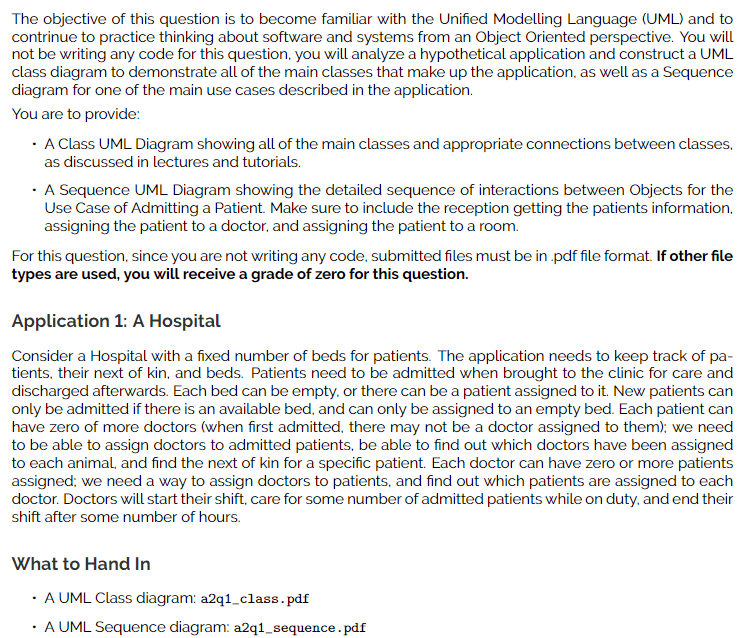
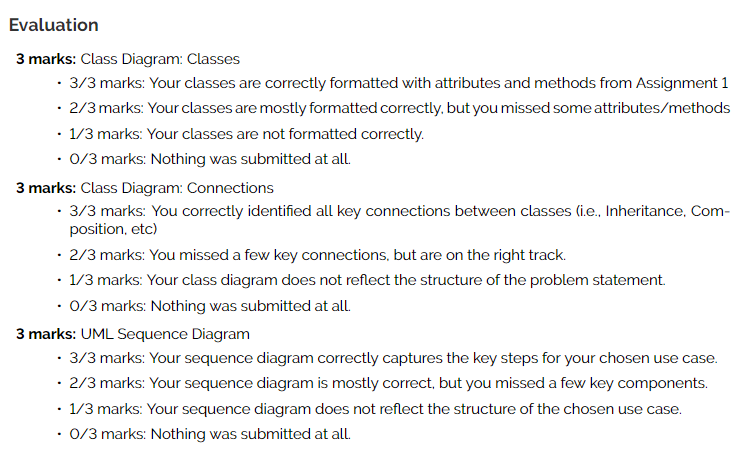

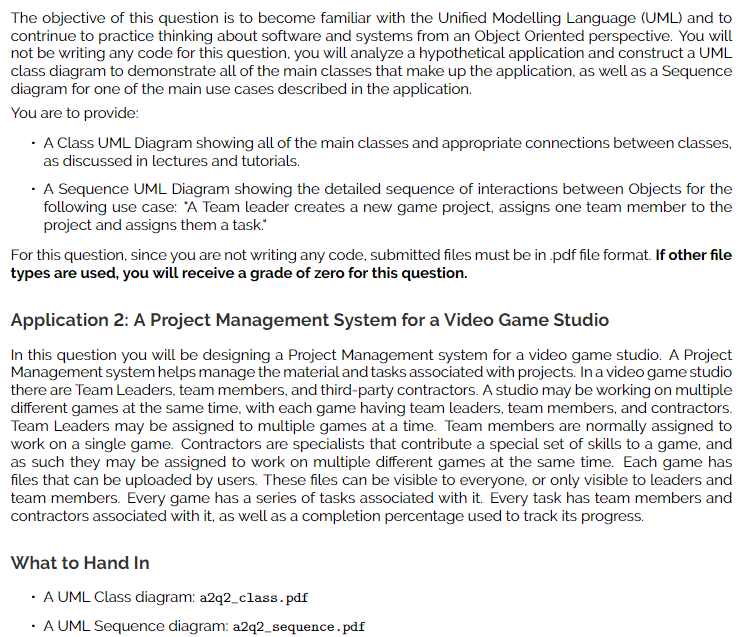
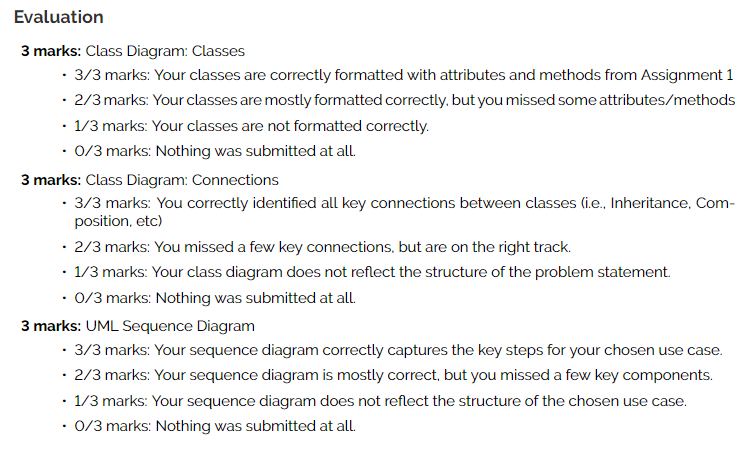



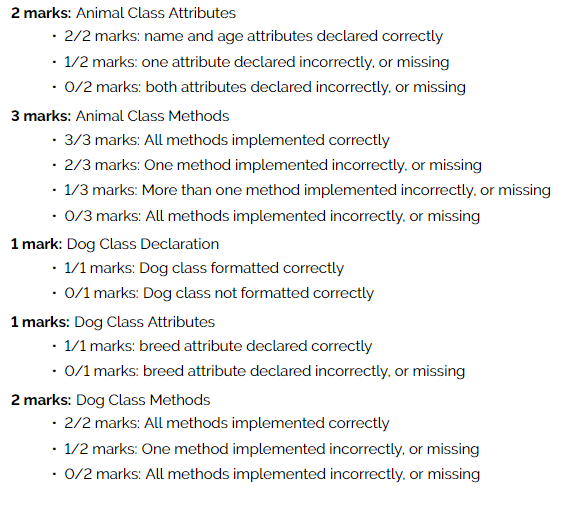
Question 1 (9 points): Purpose: To practice creating UML Class and Sequence Diagrams Degree of Difficulty: Easy. The tasks required in this assignment are not difficult, but do require thought and effort to create proper UML diagrams. This is not an assignment that can be completed last minute, so leave plenty of time to iterate on your solution during the week. The objective of this question is to become familiar with the Unified Modelling Language (UML) and to contrinue to practice thinking about software and systems from an Object Oriented perspective. You will not be writing any code for this question, you will analyze a hypothetical application and construct a UML class diagram to demonstrate all of the main classes that make up the application, as well as a Sequence diagram for one of the main use cases described in the application. You are to provide: A Class UML Diagram showing all of the main classes and appropriate connections between classes. as discussed in lectures and tutorials. A Sequence UML Diagram showing the detailed sequence of interactions between Objects for the Use Case of Admitting a Patient. Make sure to include the reception getting the patients information, assigning the patient to a doctor, and assigning the patient to a room. For this question, since you are not writing any code, submitted files must be in .pdf file format. If other file types are used, you will receive a grade of zero for this question. Application 1: A Hospital Consider a Hospital with a fixed number of beds for patients. The application needs to keep track of pa- tients, their next of kin, and beds. Patients need to be admitted when brought to the clinic for care and discharged afterwards. Each bed can be empty, or there can be a patient assigned to it. New patients can only be admitted if there is an available bed, and can only be assigned to an empty bed. Each patient can have zero of more doctors (when first admitted, there may not be a doctor assigned to them); we need to be able to assign doctors to admitted patients, be able to find out which doctors have been assigned to each animal, and find the next of kin for a specific patient. Each doctor can have zero or more patients assigned; we need a way to assign doctors to patients, and find out which patients are assigned to each doctor. Doctors will start their shift, care for some number of admitted patients while on duty, and end their shift after some number of hours. What to Hand In . A UML Class diagram: a2q1_class.pdf A UML Sequence diagram: a2q1_sequence.pdf Evaluation 3 marks: Class Diagram: Classes 3/3 marks: Your classes are correctly formatted with attributes and methods from Assignment 1 2/3 marks: Your classes are mostly formatted correctly, but you missed some attributes/methods 1/3 marks: Your classes are not formatted correctly. 0/3 marks: Nothing was submitted at all. 3 marks: Class Diagram: Connections 3/3 marks: You correctly identified all key connections between classes (i.e., Inheritance, Com- position, etc) - 2/3 marks: You missed a few key connections, but are on the right track. 1/3 marks: Your class diagram does not reflect the structure of the problem statement. 0/3 marks: Nothing was submitted at all. 3 marks: UML Sequence Diagram 3/3 marks: Your sequence diagram correctly captures the key steps for your chosen use case. 2/3 marks: Your sequence diagram is mostly correct, but you missed a few key components. 1/3 marks: Your sequence diagram does not reflect the structure of the chosen use case. 0/3 marks: Nothing was submitted at all. . Question 2 (9 points): Purpose: To practice creating UML Class and Sequence Diagrams Degree of Difficulty: Easy. The tasks required in this assignment are not difficult, but do require thought and effort to create proper UML diagrams. This is not an assignment that can be completed last minute, so leave plenty of time to iterate on your solution during the week. The objective of this question is to become familiar with the Unified Modelling Language (UML) and to contrinue to practice thinking about software and systems from an Object Oriented perspective. You will not be writing any code for this question, you will analyze a hypothetical application and construct a UML class diagram to demonstrate all of the main classes that make up the application, as well as a Sequence diagram for one of the main use cases described in the application. You are to provide: A Class UML Diagram showing all of the main classes and appropriate connections between classes, as discussed in lectures and tutorials. A Sequence UML Diagram showing the detailed sequence of interactions between Objects for the following use case: "A Team leader creates a new game project, assigns one team member to the project and assigns them a task. For this question, since you are not writing any code, submitted files must be in .pdf file format. If other file types are used, you will receive a grade of zero for this question. Application 2: A Project Management System for a Video Game Studio In this question you will be designing a Project Management system for a video game studio. A Project Management system helps manage the material and tasks associated with projects. In a video game studio there are Team Leaders, team members, and third-party contractors. A studio may be working on multiple different games at the same time, with each game having team leaders, team members, and contractors. Team Leaders may be assigned to multiple games at a time. Team members are normally assigned to work on a single game. Contractors are specialists that contribute a special set of skills to a game, and as such they may be assigned to work on multiple different games at the same time. Each game has files that can be uploaded by users. These files can be visible to everyone, or only visible to leaders and team members. Every game has a series of tasks associated with it. Every task has team members and contractors associated with it, as well as a completion percentage used to track its progress. What to Hand In A UML Class diagram: a2q2_class.pdf A UML Sequence diagram: a2q2_sequence.pdf Evaluation 3 marks: Class Diagram: Classes 3/3 marks: Your classes are correctly formatted with attributes and methods from Assignment 1 - 2/3 marks: Your classes are mostly formatted correctly, but you missed some attributes/methods 1/3 marks: Your classes are not formatted correctly. 0/3 marks: Nothing was submitted at all. 3 marks: Class Diagram: Connections 3/3 marks: You correctly identified all key connections between classes (i.e., Inheritance, Com- position, etc) 2/3 marks: You missed a few key connections, but are on the right track. 1/3 marks: Your class diagram does not reflect the structure of the problem statement. 0/3 marks: Nothing was submitted at all. 3 marks: UML Sequence Diagram 3/3 marks: Your sequence diagram correctly captures the key steps for your chosen use case. 2/3 marks: Your sequence diagram is mostly correct, but you missed a few key components. 1/3 marks: Your sequence diagram does not reflect the structure of the chosen use case. 0/3 marks: Nothing was submitted at all. Question 3 (10 points): Purpose: To practice writing java classes and implementing inheritance Degree of Difficulty: Easy. The tasks required in this assignment should not be difficult, but given it's the first time writing java code, it may take longer than expected. The objective of this question is to learn how to create java classes and implement inheritance relationships. You will be creating two entity classes based off of the UML Class Diagram below: Animal -name:String -age:Integer +Animal(name:String, age:Integer) +eat() +getName(): String +getAge():Integer Dog -breed:String +Dog(breed:String) +bark() +getBreed(): String What to Hand In A java file for Animal class: Animal.java A java file for Dog class: Dog.java Evaluation 1 Mark: Animal Class Declaration 1/1 marks: Animal Class formatted correctly. 0/1 marks: Animal Class not formatted correctly 2 marks: Animal Class Attributes 2/2 marks: name and age attributes declared correctly 1/2 marks: one attribute declared incorrectly, or missing 0/2 marks: both attributes declared incorrectly, or missing 3 marks: Animal Class Methods 3/3 marks: All methods implemented correctly 2/3 marks: One method implemented incorrectly, or missing . 1/3 marks: More than one method implemented incorrectly, or missing . 0/3 marks: All methods implemented incorrectly, or missing 1 mark: Dog Class Declaration 1/1 marks: Dog class formatted correctly - 0/1 marks: Dog class not formatted correctly 1 marks: Dog Class Attributes 1/1 marks: breed attribute declared correctly 0/1 marks: breed attribute declared incorrectly, or missing 2 marks: Dog Class Methods - 2/2 marks: All methods implemented correctly 1/2 marks: One method implemented incorrectly, or missing . 0/2 marks: All methods implemented incorrectly, or missing
Step by Step Solution
★★★★★
3.33 Rating (159 Votes )
There are 3 Steps involved in it
Step: 1
Question Number 1 A Class UML Diagram Classes Identify the main classes such as Patient Doctor Bed Reception and NextOfKin Attributes Methods Include relevant attributes and methods for each class bas...
Get Instant Access to Expert-Tailored Solutions
See step-by-step solutions with expert insights and AI powered tools for academic success
Step: 2

Step: 3

Ace Your Homework with AI
Get the answers you need in no time with our AI-driven, step-by-step assistance
Get Started


